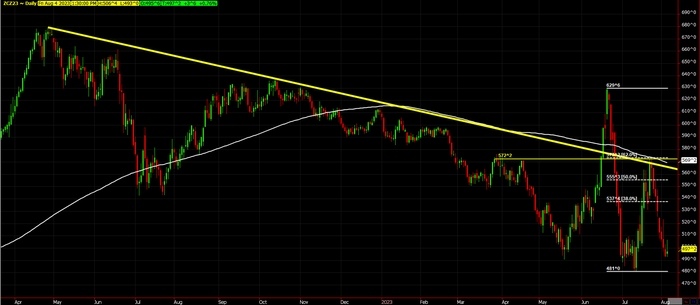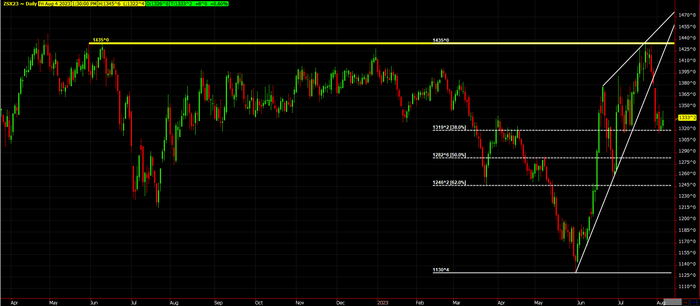
Second chance opportunities to make corn sales were offered during the month of July, but emotions were running just as high as in June and a disciplined approach was necessary to take advantage of the rally.
Corn’s rally ultimately failed at a convergence of four significant technical targets and was barely able to hold onto the $5 handle at month’s end. The push higher in December corn reached $5.7225, which was a penny shy of both the 200-day moving average (white line on chart) and the 62% retracement of the break from June high to July low. The down trend line from last year’s contract high to the October fall high (yellow down trend) also provided resistance while the highs made around the March Quarterly Stocks and Prospective Plantings report proved another component of technical resistance the rally couldn’t break.

While December corn did still finish July 18.25 cents higher than June’s settlement, it is a small victory since it was 59.25 cents off the high for the month. November soybeans performed even worse at month’s end settling 11.5 cents lower than June’s settlement and $1.0325 lower than the high for the month made just five sessions prior to month’s end. The $14.35 November soybean high made during July was a meager 13.25 cents lower than last year’s contract high made in April, and matched last year’s secondary bounce made in late April.
Like corn, soybeans reached significant technical objective before ultimately succumbing to aggressive selling late month as extreme heat finally broke while future weather forecasts improved. A bearish ascending wedge (white trend lines) has formed on the chart and Monday’s gap lower broke the uptrend of the wedge. A move below this week’s low, which matches the July monthly low, will likely bring additional technical selling with $12.8275 and $12.4625 being the next retracement objectives.

Headlines impact technicals
The market’s focus next week will likely be three-fold: additional developments in Russia/Ukraine, weather forecast evolution, and Friday’s August WASDE report.
Mid-month attacks on grain facilities along the Danube River forced shorts in wheat to cover aggressively with HRW and SRW rallying $1.3775 and $1.4525 respectively off the July WASDE report lows. Corn went along for much of that ride, but incredibly both varieties of wheat are back to or below those July lows.
Additional headlines this week did not provide the same reaction as in July. Grain facilities were again attacked on the Danube River and a Russian vessel was attacked by a Ukrainian drone near a Russian grain port, but both rallies that occurred during the night session were met with selling during the day session.
Weather watch
According to Empire Weather, a low-pressure system was tracking across the Northern Plains into the Midwest this past weekend with a widespread swath of rainfall. In addition to the risk of heavy rain, this system had the risk for severe weather. The pattern remains active across the Corn Belt into this week.
Temperatures remained warm across the Corn Belt through the end of last week, but a much cooler pattern is emerging this week. Below average temperatures are expected through next week as a trough deepens across the Midwest. The pattern remains active with additional opportunities for precipitation over the next two weeks.
The fast-moving mid-level jet will guide additional systems and disturbances through the Midwest and Central U.S. A much cooler pattern with near to below normal temps is shown. This should be seen as a negative influence next week if the forecast looks similar coming out of the weekend.
Lower yields ahead?
Finally, next week’s report will offer updated yield estimates with most market chatter looking for lower yields for both corn and soybeans. USDA’s balance sheet for corn is still using an immense 805 million bushels of additional demand year over year which will likely be used to offset any yield reductions. Roughly half of that extra demand is in the Feed/Residual category, which could be hard to justify with the number of animal units on feed.
Soybeans, however, do not have a balance sheet that offers the same cushion due to the significant decrease in acres from the June report. While new crop export commitments remain just over 7 million metric tonnes (MMT) behind year ago levels, China has been active over the last week purchasing just over 1.5 MMT. These recent purchases seem to have been enough keep soybeans from plummeting on weather forecasts.
One thing I’ll leave you with as you prepare for your week is to consider the new crop corn sales you have made and whether you intend to store those bushels or deliver out of the field. New crop corn is currently offering 26 cents of carry from December to July. Any sales you have on the books priced off the December contract that are going in the bin, whether on the board or with your local merchandiser, should have targets established to roll to capture carry. Your risk from here (from a spread perspective) is that the crop ends up continuing to shrink and /or producers plan to sell soybeans off the combine and store corn. In both events, it is feasible that the current levels of carry offered by the market will deteriorate into fall.
There are plenty of ways to protect your downside while leaving flexibility to benefit from rallies. Feel free to contact me directly at 815-665-0463 or anyone on the AgMarket.Net team at 844-4AGMRKT for assistance. We are here to help.
The risk of loss in trading futures and/or options is substantial and each investor and/or trader must consider whether this is a suitable investment. AgMarket.Net is the Farm Division of John Stewart and Associates (JSA) based out of St Joe, MO and all futures and options trades are cleared through ADMIS in Chicago IL. This material has been prepared by an agent of JSA or a third party and is, or is in the nature of, a solicitation. By accepting this communication, you agree that you are an experienced user of the futures markets, capable of making independent trading decisions, and agree that you are not, and will not, rely solely on this communication in making trading decisions. Past performance, whether actual or indicated by simulated historical tests of strategies, is not indicative of future results. Trading information and advice is based on information taken from 3rd party sources that are believed to be reliable. We do not guarantee that such information is accurate or complete and it should not be relied upon as such. Trading advice reflects our good faith judgment at a specific time and is subject to change without notice. There is no guarantee that the advice we give will result in profitable trades. The services provided by JSA may not be available in all jurisdictions. It is possible that the country in which you are a resident prohibits us from opening and maintaining an account for you.
The opinions of the author are not necessarily those of Farm Futures or Farm Progress.
About the Author(s)
You May Also Like




